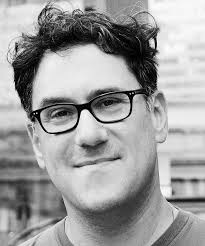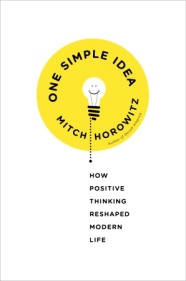
A testament to rewiring at its biggest and best, One Simple Idea: How Positive Thinking Reshaped Modern Life (Crown Publishing Group) relates the philosophical, spiritual, and scientific histories of the most redemptive of self-realizations: Thoughts are things, and they can be purposefully tooled and retooled to result in desired behaviors and outcomes.
Written by Mitch Horowitz, vice president and editor in chief at Tarcher/Penguin (the division of Penguin books dedicated to metaphysical literature), the new book is a serious and broad-ranging look at the positive-thinking movement, from the New Thought pioneers of the nineteenth century to the brain science of today. Here is an excerpt.
Changing the Brain
Since the 1990s, an intriguing courtship has emerged between certain branches of quantum theorizing and psychology. Neuroscientists and research psychiatrists, notably Jeffrey M. Schwartz, M.D., of UCLA, have been studying what has been termed neuroplasticity. Brain scans show that patients with obsessive-compulsive disorder (OCD) who repeatedly and effectively redirect their thoughts from intrusive or ritualistic impulses not only alleviate symptoms but over time can actually change their brain biology by “rewiring” neural pathways.
The necessary formula is this: When an obsessive thought or ritual begins to take hold, the individual immediately redirects his thinking to something else that is pleasurable and diverting, such as listening to music, watching a favorite TV show, or performing a desirable physical activity. After a time, researchers find, the repeated diversions actually create new nerve-cell structures in the brain, which replace the electro-neural pathways associated with OCD.
 “I propose,” Schwartz writes, “that the time has come for science to confront serious implications of the fact that directed, willed mental activity can clearly and systematically alter brain function; that the exertion of willful effort generates a physical force that has the power to change how the brain works and even its physical structure.”
“I propose,” Schwartz writes, “that the time has come for science to confront serious implications of the fact that directed, willed mental activity can clearly and systematically alter brain function; that the exertion of willful effort generates a physical force that has the power to change how the brain works and even its physical structure.”
Schwartz linked his UCLA findings to developments in quantum physics. “The implications of direct neuroplasticity combined with quantum physics,” he wrote in his 2002 book The Mind and the Brain, “cast new light on the question of humanity’s place, and role, in nature.” The co-emergence of the two fields, he argued, “suggests that the natural world evolves through an interplay between two causal processes.”
Hence, if our thought process can alter the pathways through which electrical impulses travel in the brain, and permanently change behaviors that are produced, then brain biology can be understood as the product of thought, as much as the other way around. This process, Schwartz claims, “allows human thoughts to make a difference in the evolution of 274 one simple idea physical events.” And the method at the back of it, he writes, “is what I call directed mental force.”
Brain imaging and several years of clinical study support the findings of neuroplasticity. Yet the same insight existed instinctively—and with virtually the same methods and exercises—in early New Thought. Between 1909 and 1911, minister and philosopher John Herman Randall issued a series of pamphlets that explored the ideas of positive thinking and the new mental therapeutics. He collected them in his 1911 book, A New Philosophy of Life, in which he described an intriguing method to escape nagging thoughts. Randall called it substitution. He wrote:
Divert your mind from the discordant thought by thinking in other channels. Do not wait a moment, when the wrong thought gets into your mind, but turn to the magazine or the book, and read until your mind is filled with other thoughts. Or, take up some task that calls for all your energy, and forces you to concentrate your mental activities along other lines. It may be a little difficult at first, but I want to tell you, on the experience of multitudes of men and women [that this approach] if persevered in, will succeed in every life.
Randall’s technique and terminology foreshadowed the precise method of neuroplasticity as it relates to OCD.* People fail to devise constructive new habits, Randall wrote, “because they are not persistent and patient enough in forming the new brain centres from whence must be permanently expressed the new life, that may in very truth be born in them…” And elsewhere: “Our thinking must be turned into other channels than those which we know will lead to the worrisome thoughts”—the remedy being to “substitute some new line of thought,” anything that gets us out of “narrow restricted grooves.” Randall’s insights anticipated the language and findings of twenty-first-century neuroplasticity.
* In 1904 the Nobel-winning Spanish neuro-anatomist Santiago Ramón y Cajal also had the insight that thoughts repeated by “mental practice” would reinforce neural pathways, though the brain imaging that would prove his point did not yet exist.
Excerpted from One Simple Idea: How Positive Thinking Reshaped Modern Life, by Mitch Horowitz. Copyright © 2014 Mitch Horowitz. Published by Crown Publishing Group. Reprinted by permission of the author. Watch the video or connect with Mitch at www.MitchHorowitz.com and https://twitter.com/MitchHorowitz.
Related Articles
- Mitch Horowitz Talks with Rewire Me About His New Book (interview)
- Thinking Yourself Healthy, Wealthy, and Wise: Thoughts on One Simple Idea: How Positive Thinking Reshaped Modern Life (review)



